BreadTalk's Strategic Analysis and Market Entry in New Zealand
VerifiedAdded on 2020/05/16
|19
|3708
|255
Report
AI Summary
This report provides a detailed analysis of BreadTalk's market entry strategy for New Zealand. It begins with an introduction to BreadTalk and the rationale for choosing New Zealand, followed by a STEEP analysis covering social-cultural, technological, environmental, economic, and political/legal factors. A SWOT analysis is then presented, highlighting the company's strengths, weaknesses, opportunities, and threats. The report also includes a market analysis using Porter's Five Forces to assess the competitive landscape. Finally, it outlines BreadTalk's chosen market entry mode (franchising), marketing objectives, target market, and marketing mix strategies, aiming to establish BreadTalk as a leading bakery brand in New Zealand.
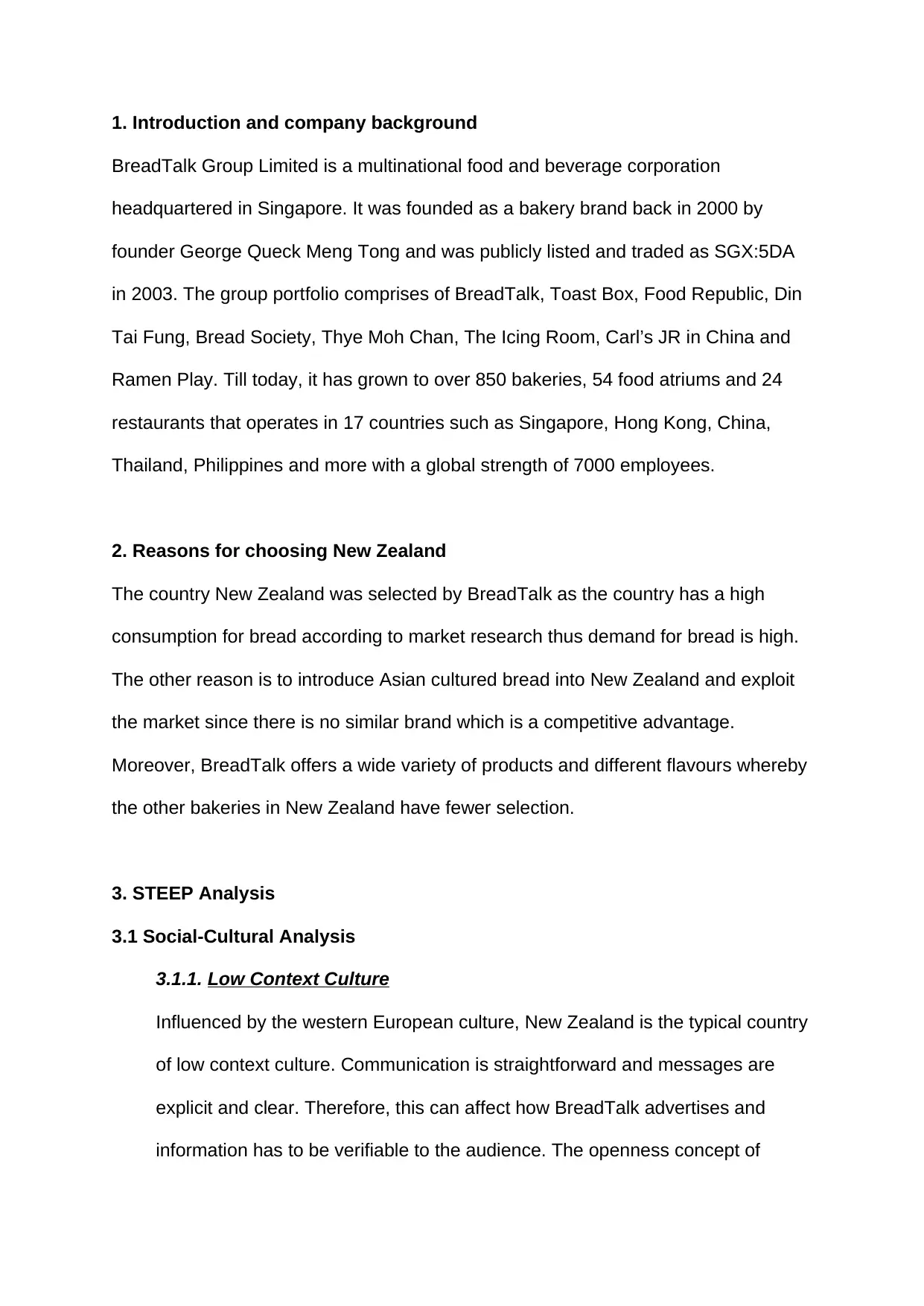
1. Introduction and company background
BreadTalk Group Limited is a multinational food and beverage corporation
headquartered in Singapore. It was founded as a bakery brand back in 2000 by
founder George Queck Meng Tong and was publicly listed and traded as SGX:5DA
in 2003. The group portfolio comprises of BreadTalk, Toast Box, Food Republic, Din
Tai Fung, Bread Society, Thye Moh Chan, The Icing Room, Carl’s JR in China and
Ramen Play. Till today, it has grown to over 850 bakeries, 54 food atriums and 24
restaurants that operates in 17 countries such as Singapore, Hong Kong, China,
Thailand, Philippines and more with a global strength of 7000 employees.
2. Reasons for choosing New Zealand
The country New Zealand was selected by BreadTalk as the country has a high
consumption for bread according to market research thus demand for bread is high.
The other reason is to introduce Asian cultured bread into New Zealand and exploit
the market since there is no similar brand which is a competitive advantage.
Moreover, BreadTalk offers a wide variety of products and different flavours whereby
the other bakeries in New Zealand have fewer selection.
3. STEEP Analysis
3.1 Social-Cultural Analysis
3.1.1. Low Context Culture
Influenced by the western European culture, New Zealand is the typical country
of low context culture. Communication is straightforward and messages are
explicit and clear. Therefore, this can affect how BreadTalk advertises and
information has to be verifiable to the audience. The openness concept of
BreadTalk Group Limited is a multinational food and beverage corporation
headquartered in Singapore. It was founded as a bakery brand back in 2000 by
founder George Queck Meng Tong and was publicly listed and traded as SGX:5DA
in 2003. The group portfolio comprises of BreadTalk, Toast Box, Food Republic, Din
Tai Fung, Bread Society, Thye Moh Chan, The Icing Room, Carl’s JR in China and
Ramen Play. Till today, it has grown to over 850 bakeries, 54 food atriums and 24
restaurants that operates in 17 countries such as Singapore, Hong Kong, China,
Thailand, Philippines and more with a global strength of 7000 employees.
2. Reasons for choosing New Zealand
The country New Zealand was selected by BreadTalk as the country has a high
consumption for bread according to market research thus demand for bread is high.
The other reason is to introduce Asian cultured bread into New Zealand and exploit
the market since there is no similar brand which is a competitive advantage.
Moreover, BreadTalk offers a wide variety of products and different flavours whereby
the other bakeries in New Zealand have fewer selection.
3. STEEP Analysis
3.1 Social-Cultural Analysis
3.1.1. Low Context Culture
Influenced by the western European culture, New Zealand is the typical country
of low context culture. Communication is straightforward and messages are
explicit and clear. Therefore, this can affect how BreadTalk advertises and
information has to be verifiable to the audience. The openness concept of
Paraphrase This Document
Need a fresh take? Get an instant paraphrase of this document with our AI Paraphraser
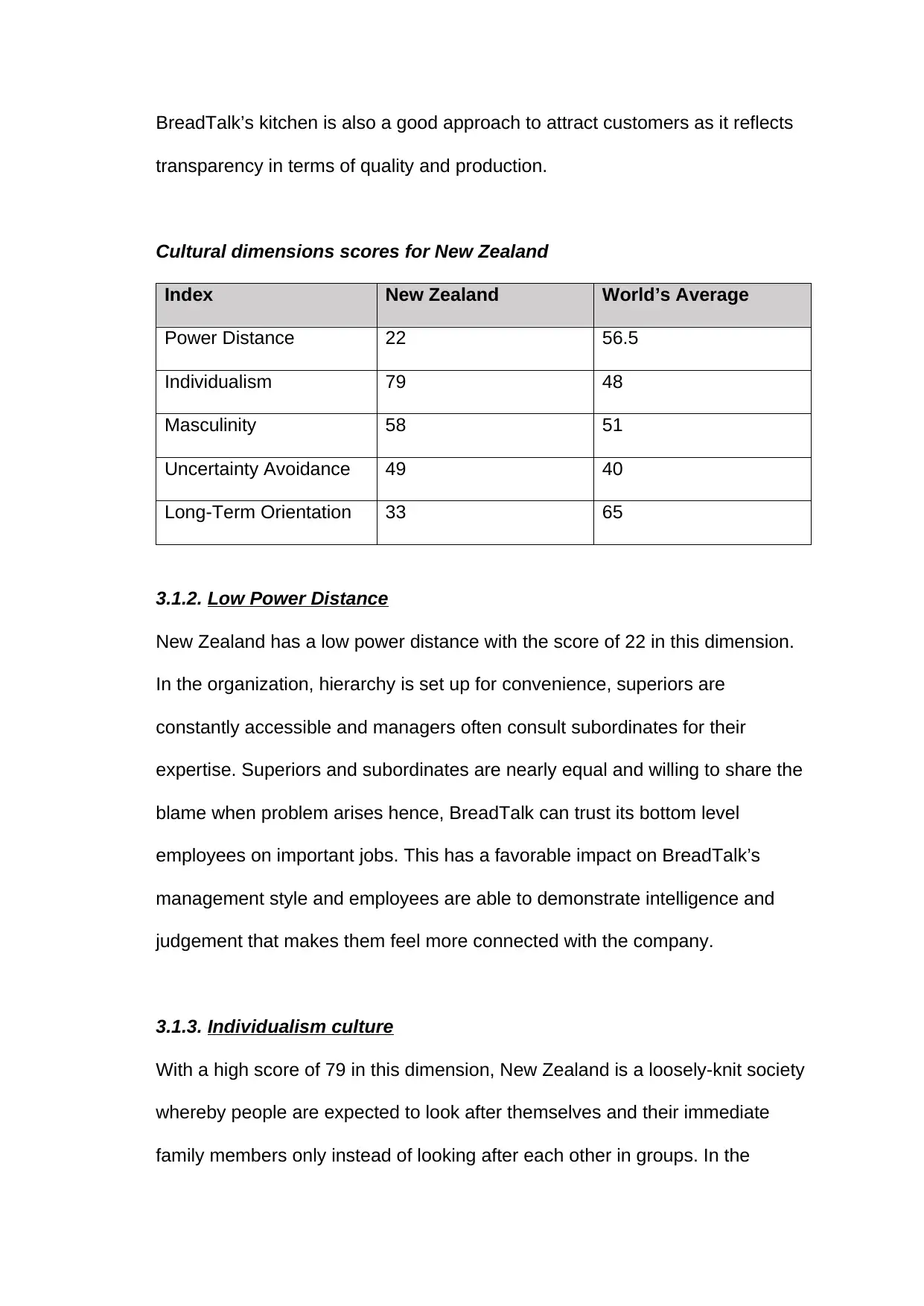
BreadTalk’s kitchen is also a good approach to attract customers as it reflects
transparency in terms of quality and production.
Cultural dimensions scores for New Zealand
Index New Zealand World’s Average
Power Distance 22 56.5
Individualism 79 48
Masculinity 58 51
Uncertainty Avoidance 49 40
Long-Term Orientation 33 65
3.1.2. Low Power Distance
New Zealand has a low power distance with the score of 22 in this dimension.
In the organization, hierarchy is set up for convenience, superiors are
constantly accessible and managers often consult subordinates for their
expertise. Superiors and subordinates are nearly equal and willing to share the
blame when problem arises hence, BreadTalk can trust its bottom level
employees on important jobs. This has a favorable impact on BreadTalk’s
management style and employees are able to demonstrate intelligence and
judgement that makes them feel more connected with the company.
3.1.3. Individualism culture
With a high score of 79 in this dimension, New Zealand is a loosely-knit society
whereby people are expected to look after themselves and their immediate
family members only instead of looking after each other in groups. In the
transparency in terms of quality and production.
Cultural dimensions scores for New Zealand
Index New Zealand World’s Average
Power Distance 22 56.5
Individualism 79 48
Masculinity 58 51
Uncertainty Avoidance 49 40
Long-Term Orientation 33 65
3.1.2. Low Power Distance
New Zealand has a low power distance with the score of 22 in this dimension.
In the organization, hierarchy is set up for convenience, superiors are
constantly accessible and managers often consult subordinates for their
expertise. Superiors and subordinates are nearly equal and willing to share the
blame when problem arises hence, BreadTalk can trust its bottom level
employees on important jobs. This has a favorable impact on BreadTalk’s
management style and employees are able to demonstrate intelligence and
judgement that makes them feel more connected with the company.
3.1.3. Individualism culture
With a high score of 79 in this dimension, New Zealand is a loosely-knit society
whereby people are expected to look after themselves and their immediate
family members only instead of looking after each other in groups. In the
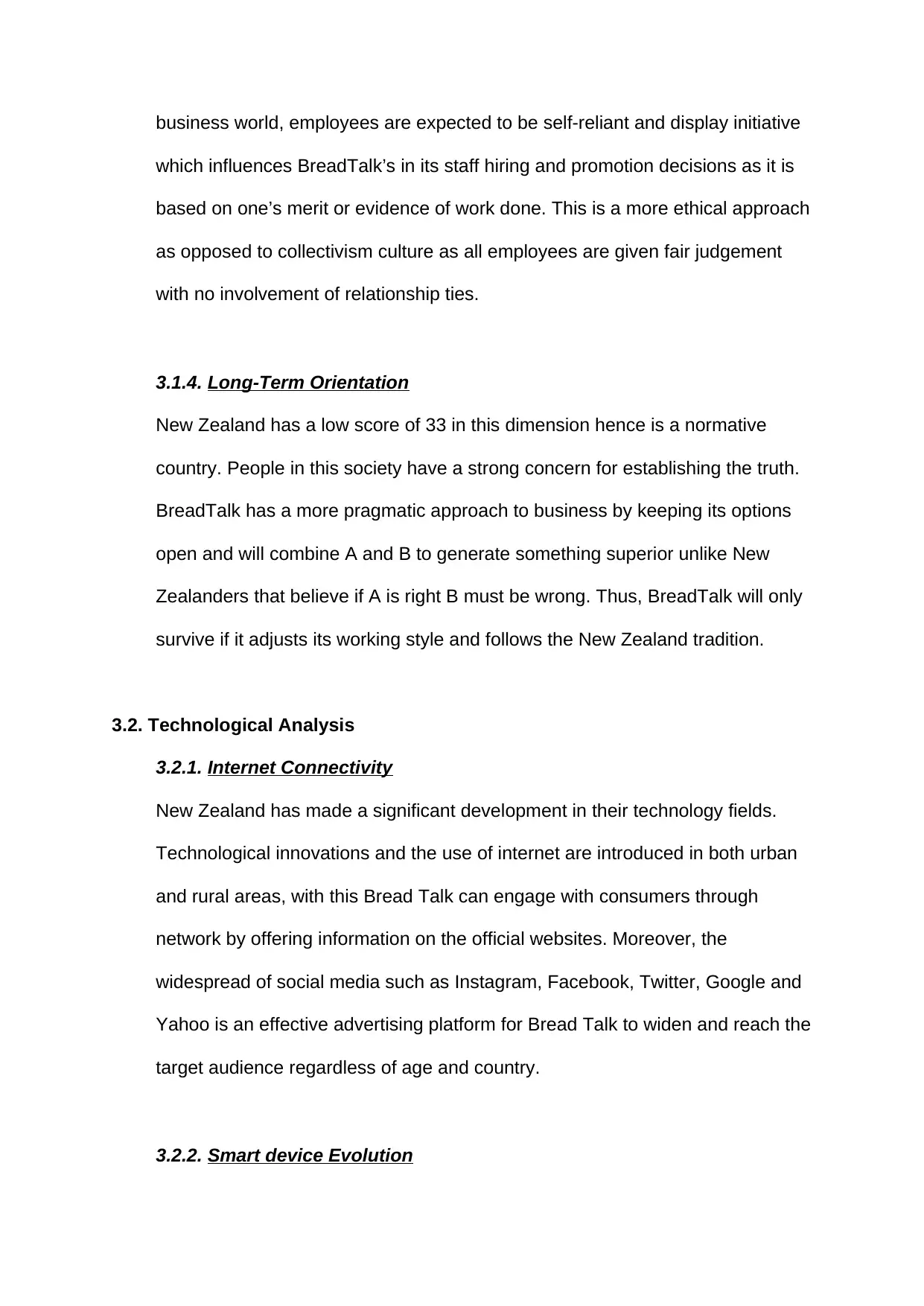
business world, employees are expected to be self-reliant and display initiative
which influences BreadTalk’s in its staff hiring and promotion decisions as it is
based on one’s merit or evidence of work done. This is a more ethical approach
as opposed to collectivism culture as all employees are given fair judgement
with no involvement of relationship ties.
3.1.4. Long-Term Orientation
New Zealand has a low score of 33 in this dimension hence is a normative
country. People in this society have a strong concern for establishing the truth.
BreadTalk has a more pragmatic approach to business by keeping its options
open and will combine A and B to generate something superior unlike New
Zealanders that believe if A is right B must be wrong. Thus, BreadTalk will only
survive if it adjusts its working style and follows the New Zealand tradition.
3.2. Technological Analysis
3.2.1. Internet Connectivity
New Zealand has made a significant development in their technology fields.
Technological innovations and the use of internet are introduced in both urban
and rural areas, with this Bread Talk can engage with consumers through
network by offering information on the official websites. Moreover, the
widespread of social media such as Instagram, Facebook, Twitter, Google and
Yahoo is an effective advertising platform for Bread Talk to widen and reach the
target audience regardless of age and country.
3.2.2. Smart device Evolution
which influences BreadTalk’s in its staff hiring and promotion decisions as it is
based on one’s merit or evidence of work done. This is a more ethical approach
as opposed to collectivism culture as all employees are given fair judgement
with no involvement of relationship ties.
3.1.4. Long-Term Orientation
New Zealand has a low score of 33 in this dimension hence is a normative
country. People in this society have a strong concern for establishing the truth.
BreadTalk has a more pragmatic approach to business by keeping its options
open and will combine A and B to generate something superior unlike New
Zealanders that believe if A is right B must be wrong. Thus, BreadTalk will only
survive if it adjusts its working style and follows the New Zealand tradition.
3.2. Technological Analysis
3.2.1. Internet Connectivity
New Zealand has made a significant development in their technology fields.
Technological innovations and the use of internet are introduced in both urban
and rural areas, with this Bread Talk can engage with consumers through
network by offering information on the official websites. Moreover, the
widespread of social media such as Instagram, Facebook, Twitter, Google and
Yahoo is an effective advertising platform for Bread Talk to widen and reach the
target audience regardless of age and country.
3.2.2. Smart device Evolution
⊘ This is a preview!⊘
Do you want full access?
Subscribe today to unlock all pages.

Trusted by 1+ million students worldwide
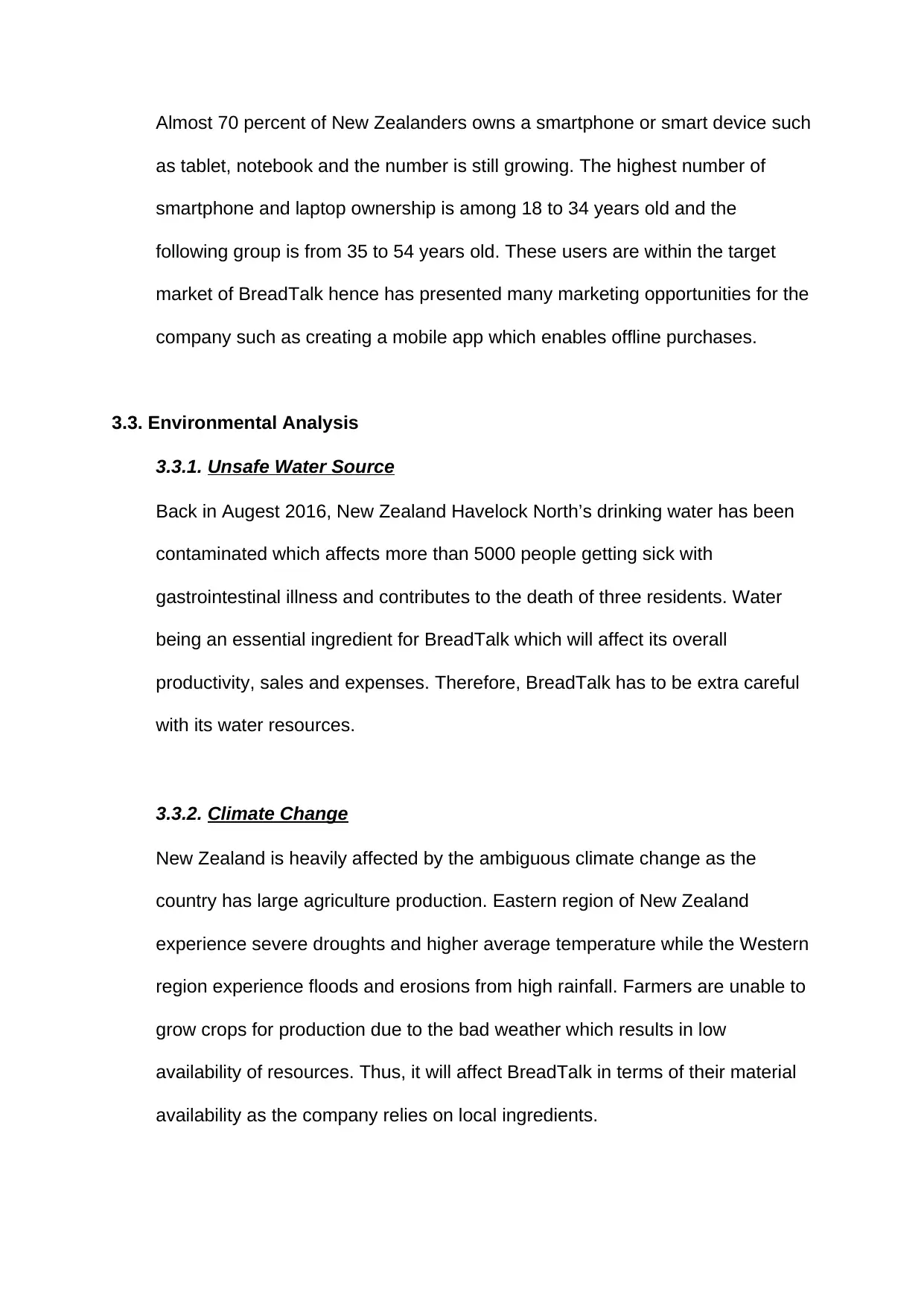
Almost 70 percent of New Zealanders owns a smartphone or smart device such
as tablet, notebook and the number is still growing. The highest number of
smartphone and laptop ownership is among 18 to 34 years old and the
following group is from 35 to 54 years old. These users are within the target
market of BreadTalk hence has presented many marketing opportunities for the
company such as creating a mobile app which enables offline purchases.
3.3. Environmental Analysis
3.3.1. Unsafe Water Source
Back in Augest 2016, New Zealand Havelock North’s drinking water has been
contaminated which affects more than 5000 people getting sick with
gastrointestinal illness and contributes to the death of three residents. Water
being an essential ingredient for BreadTalk which will affect its overall
productivity, sales and expenses. Therefore, BreadTalk has to be extra careful
with its water resources.
3.3.2. Climate Change
New Zealand is heavily affected by the ambiguous climate change as the
country has large agriculture production. Eastern region of New Zealand
experience severe droughts and higher average temperature while the Western
region experience floods and erosions from high rainfall. Farmers are unable to
grow crops for production due to the bad weather which results in low
availability of resources. Thus, it will affect BreadTalk in terms of their material
availability as the company relies on local ingredients.
as tablet, notebook and the number is still growing. The highest number of
smartphone and laptop ownership is among 18 to 34 years old and the
following group is from 35 to 54 years old. These users are within the target
market of BreadTalk hence has presented many marketing opportunities for the
company such as creating a mobile app which enables offline purchases.
3.3. Environmental Analysis
3.3.1. Unsafe Water Source
Back in Augest 2016, New Zealand Havelock North’s drinking water has been
contaminated which affects more than 5000 people getting sick with
gastrointestinal illness and contributes to the death of three residents. Water
being an essential ingredient for BreadTalk which will affect its overall
productivity, sales and expenses. Therefore, BreadTalk has to be extra careful
with its water resources.
3.3.2. Climate Change
New Zealand is heavily affected by the ambiguous climate change as the
country has large agriculture production. Eastern region of New Zealand
experience severe droughts and higher average temperature while the Western
region experience floods and erosions from high rainfall. Farmers are unable to
grow crops for production due to the bad weather which results in low
availability of resources. Thus, it will affect BreadTalk in terms of their material
availability as the company relies on local ingredients.
Paraphrase This Document
Need a fresh take? Get an instant paraphrase of this document with our AI Paraphraser
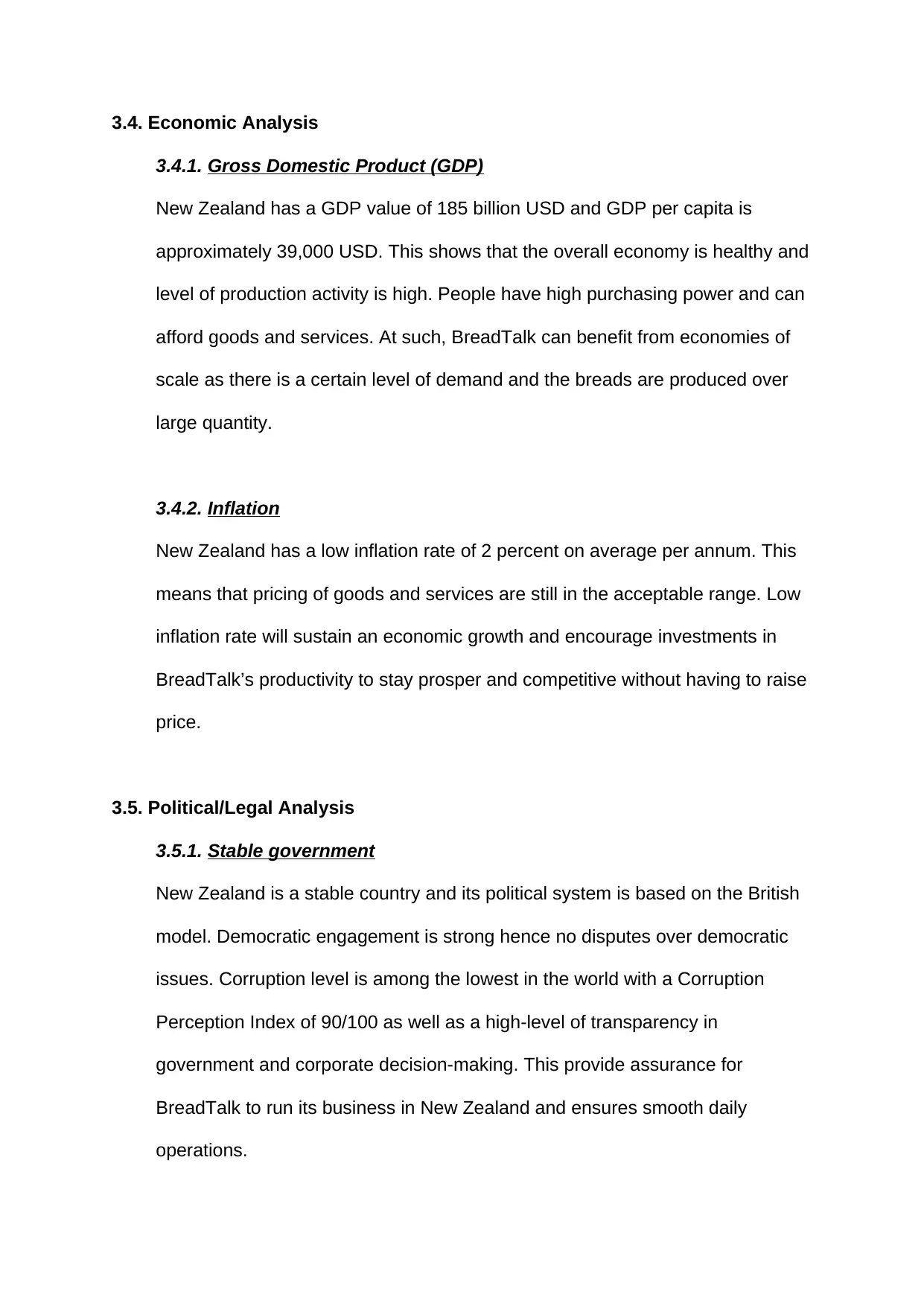
3.4. Economic Analysis
3.4.1. Gross Domestic Product (GDP)
New Zealand has a GDP value of 185 billion USD and GDP per capita is
approximately 39,000 USD. This shows that the overall economy is healthy and
level of production activity is high. People have high purchasing power and can
afford goods and services. At such, BreadTalk can benefit from economies of
scale as there is a certain level of demand and the breads are produced over
large quantity.
3.4.2. Inflation
New Zealand has a low inflation rate of 2 percent on average per annum. This
means that pricing of goods and services are still in the acceptable range. Low
inflation rate will sustain an economic growth and encourage investments in
BreadTalk’s productivity to stay prosper and competitive without having to raise
price.
3.5. Political/Legal Analysis
3.5.1. Stable government
New Zealand is a stable country and its political system is based on the British
model. Democratic engagement is strong hence no disputes over democratic
issues. Corruption level is among the lowest in the world with a Corruption
Perception Index of 90/100 as well as a high-level of transparency in
government and corporate decision-making. This provide assurance for
BreadTalk to run its business in New Zealand and ensures smooth daily
operations.
3.4.1. Gross Domestic Product (GDP)
New Zealand has a GDP value of 185 billion USD and GDP per capita is
approximately 39,000 USD. This shows that the overall economy is healthy and
level of production activity is high. People have high purchasing power and can
afford goods and services. At such, BreadTalk can benefit from economies of
scale as there is a certain level of demand and the breads are produced over
large quantity.
3.4.2. Inflation
New Zealand has a low inflation rate of 2 percent on average per annum. This
means that pricing of goods and services are still in the acceptable range. Low
inflation rate will sustain an economic growth and encourage investments in
BreadTalk’s productivity to stay prosper and competitive without having to raise
price.
3.5. Political/Legal Analysis
3.5.1. Stable government
New Zealand is a stable country and its political system is based on the British
model. Democratic engagement is strong hence no disputes over democratic
issues. Corruption level is among the lowest in the world with a Corruption
Perception Index of 90/100 as well as a high-level of transparency in
government and corporate decision-making. This provide assurance for
BreadTalk to run its business in New Zealand and ensures smooth daily
operations.
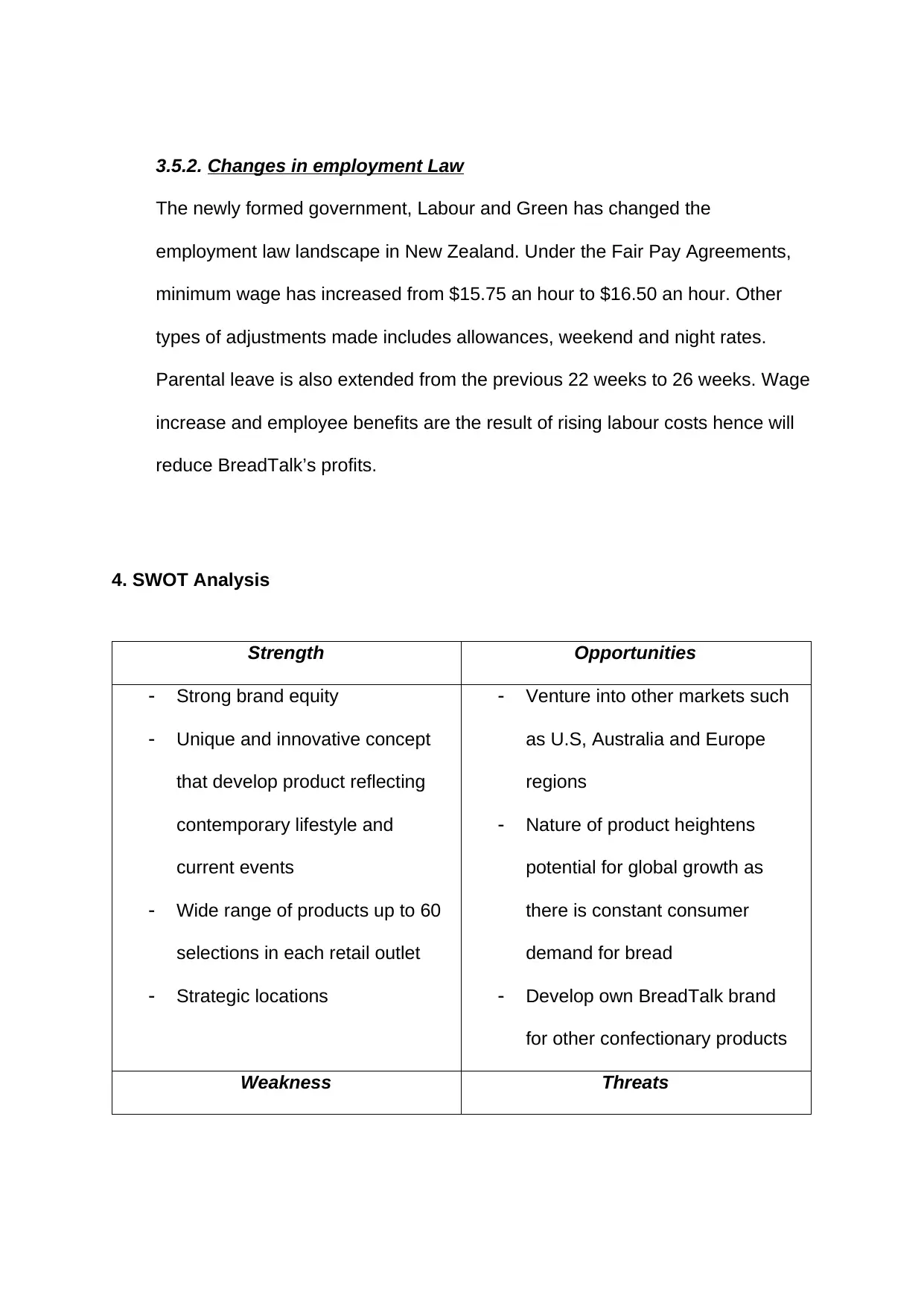
3.5.2. Changes in employment Law
The newly formed government, Labour and Green has changed the
employment law landscape in New Zealand. Under the Fair Pay Agreements,
minimum wage has increased from $15.75 an hour to $16.50 an hour. Other
types of adjustments made includes allowances, weekend and night rates.
Parental leave is also extended from the previous 22 weeks to 26 weeks. Wage
increase and employee benefits are the result of rising labour costs hence will
reduce BreadTalk’s profits.
4. SWOT Analysis
Strength Opportunities
Strong brand equity
Unique and innovative concept
that develop product reflecting
contemporary lifestyle and
current events
Wide range of products up to 60
selections in each retail outlet
Strategic locations
Venture into other markets such
as U.S, Australia and Europe
regions
Nature of product heightens
potential for global growth as
there is constant consumer
demand for bread
Develop own BreadTalk brand
for other confectionary products
Weakness Threats
The newly formed government, Labour and Green has changed the
employment law landscape in New Zealand. Under the Fair Pay Agreements,
minimum wage has increased from $15.75 an hour to $16.50 an hour. Other
types of adjustments made includes allowances, weekend and night rates.
Parental leave is also extended from the previous 22 weeks to 26 weeks. Wage
increase and employee benefits are the result of rising labour costs hence will
reduce BreadTalk’s profits.
4. SWOT Analysis
Strength Opportunities
Strong brand equity
Unique and innovative concept
that develop product reflecting
contemporary lifestyle and
current events
Wide range of products up to 60
selections in each retail outlet
Strategic locations
Venture into other markets such
as U.S, Australia and Europe
regions
Nature of product heightens
potential for global growth as
there is constant consumer
demand for bread
Develop own BreadTalk brand
for other confectionary products
Weakness Threats
⊘ This is a preview!⊘
Do you want full access?
Subscribe today to unlock all pages.

Trusted by 1+ million students worldwide
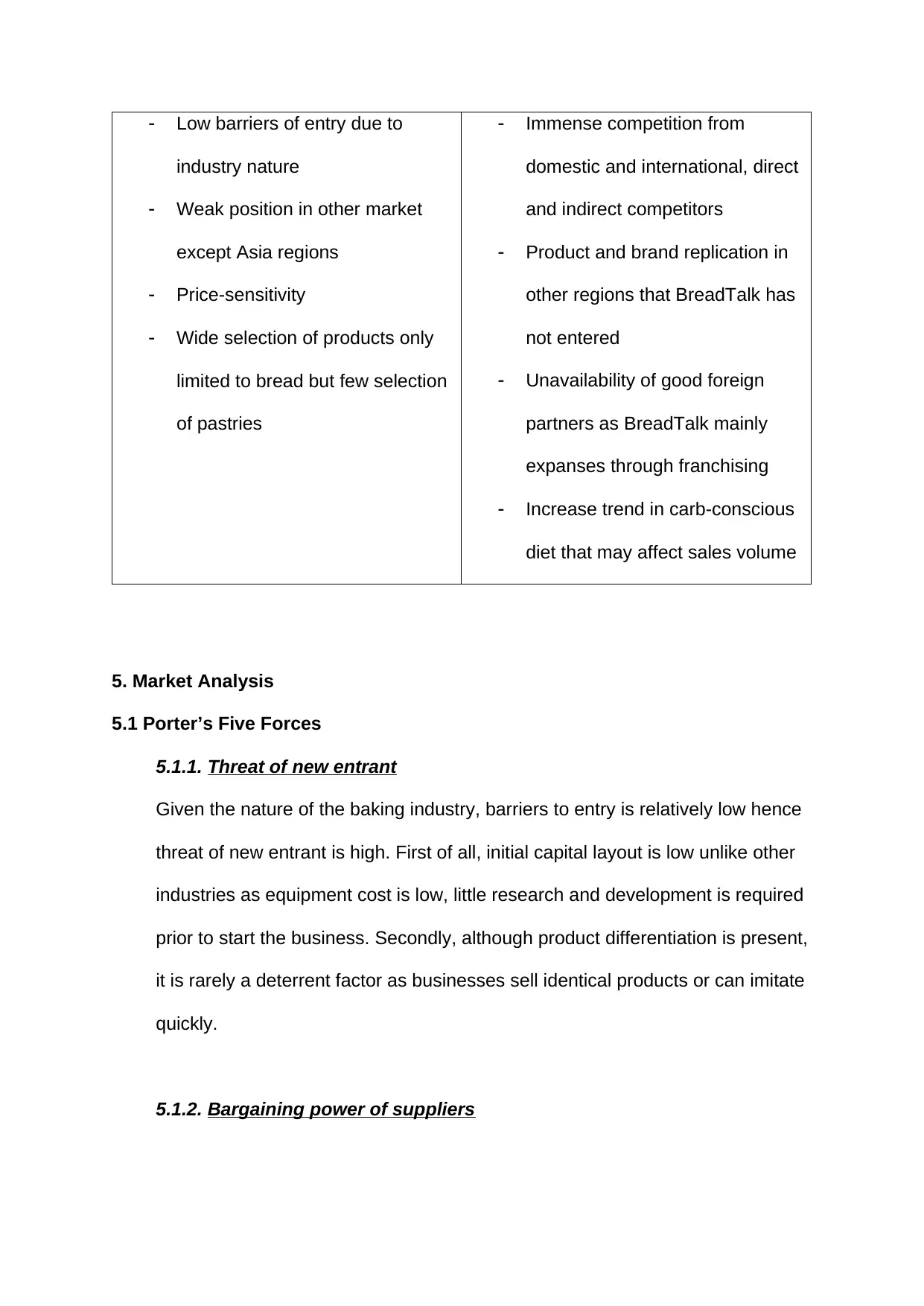
Low barriers of entry due to
industry nature
Weak position in other market
except Asia regions
Price-sensitivity
Wide selection of products only
limited to bread but few selection
of pastries
Immense competition from
domestic and international, direct
and indirect competitors
Product and brand replication in
other regions that BreadTalk has
not entered
Unavailability of good foreign
partners as BreadTalk mainly
expanses through franchising
Increase trend in carb-conscious
diet that may affect sales volume
5. Market Analysis
5.1 Porter’s Five Forces
5.1.1. Threat of new entrant
Given the nature of the baking industry, barriers to entry is relatively low hence
threat of new entrant is high. First of all, initial capital layout is low unlike other
industries as equipment cost is low, little research and development is required
prior to start the business. Secondly, although product differentiation is present,
it is rarely a deterrent factor as businesses sell identical products or can imitate
quickly.
5.1.2. Bargaining power of suppliers
industry nature
Weak position in other market
except Asia regions
Price-sensitivity
Wide selection of products only
limited to bread but few selection
of pastries
Immense competition from
domestic and international, direct
and indirect competitors
Product and brand replication in
other regions that BreadTalk has
not entered
Unavailability of good foreign
partners as BreadTalk mainly
expanses through franchising
Increase trend in carb-conscious
diet that may affect sales volume
5. Market Analysis
5.1 Porter’s Five Forces
5.1.1. Threat of new entrant
Given the nature of the baking industry, barriers to entry is relatively low hence
threat of new entrant is high. First of all, initial capital layout is low unlike other
industries as equipment cost is low, little research and development is required
prior to start the business. Secondly, although product differentiation is present,
it is rarely a deterrent factor as businesses sell identical products or can imitate
quickly.
5.1.2. Bargaining power of suppliers
Paraphrase This Document
Need a fresh take? Get an instant paraphrase of this document with our AI Paraphraser
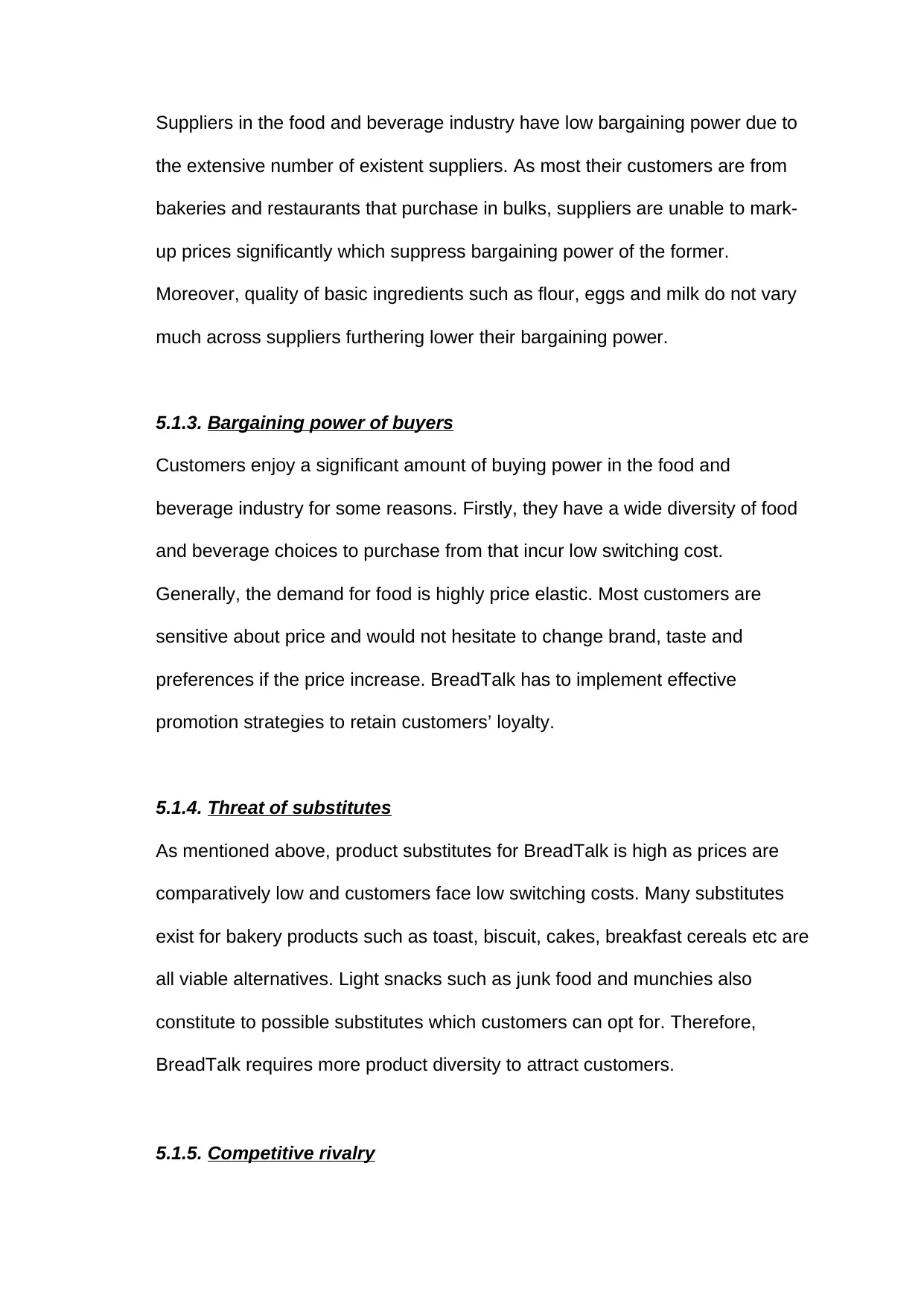
Suppliers in the food and beverage industry have low bargaining power due to
the extensive number of existent suppliers. As most their customers are from
bakeries and restaurants that purchase in bulks, suppliers are unable to mark-
up prices significantly which suppress bargaining power of the former.
Moreover, quality of basic ingredients such as flour, eggs and milk do not vary
much across suppliers furthering lower their bargaining power.
5.1.3. Bargaining power of buyers
Customers enjoy a significant amount of buying power in the food and
beverage industry for some reasons. Firstly, they have a wide diversity of food
and beverage choices to purchase from that incur low switching cost.
Generally, the demand for food is highly price elastic. Most customers are
sensitive about price and would not hesitate to change brand, taste and
preferences if the price increase. BreadTalk has to implement effective
promotion strategies to retain customers’ loyalty.
5.1.4. Threat of substitutes
As mentioned above, product substitutes for BreadTalk is high as prices are
comparatively low and customers face low switching costs. Many substitutes
exist for bakery products such as toast, biscuit, cakes, breakfast cereals etc are
all viable alternatives. Light snacks such as junk food and munchies also
constitute to possible substitutes which customers can opt for. Therefore,
BreadTalk requires more product diversity to attract customers.
5.1.5. Competitive rivalry
the extensive number of existent suppliers. As most their customers are from
bakeries and restaurants that purchase in bulks, suppliers are unable to mark-
up prices significantly which suppress bargaining power of the former.
Moreover, quality of basic ingredients such as flour, eggs and milk do not vary
much across suppliers furthering lower their bargaining power.
5.1.3. Bargaining power of buyers
Customers enjoy a significant amount of buying power in the food and
beverage industry for some reasons. Firstly, they have a wide diversity of food
and beverage choices to purchase from that incur low switching cost.
Generally, the demand for food is highly price elastic. Most customers are
sensitive about price and would not hesitate to change brand, taste and
preferences if the price increase. BreadTalk has to implement effective
promotion strategies to retain customers’ loyalty.
5.1.4. Threat of substitutes
As mentioned above, product substitutes for BreadTalk is high as prices are
comparatively low and customers face low switching costs. Many substitutes
exist for bakery products such as toast, biscuit, cakes, breakfast cereals etc are
all viable alternatives. Light snacks such as junk food and munchies also
constitute to possible substitutes which customers can opt for. Therefore,
BreadTalk requires more product diversity to attract customers.
5.1.5. Competitive rivalry
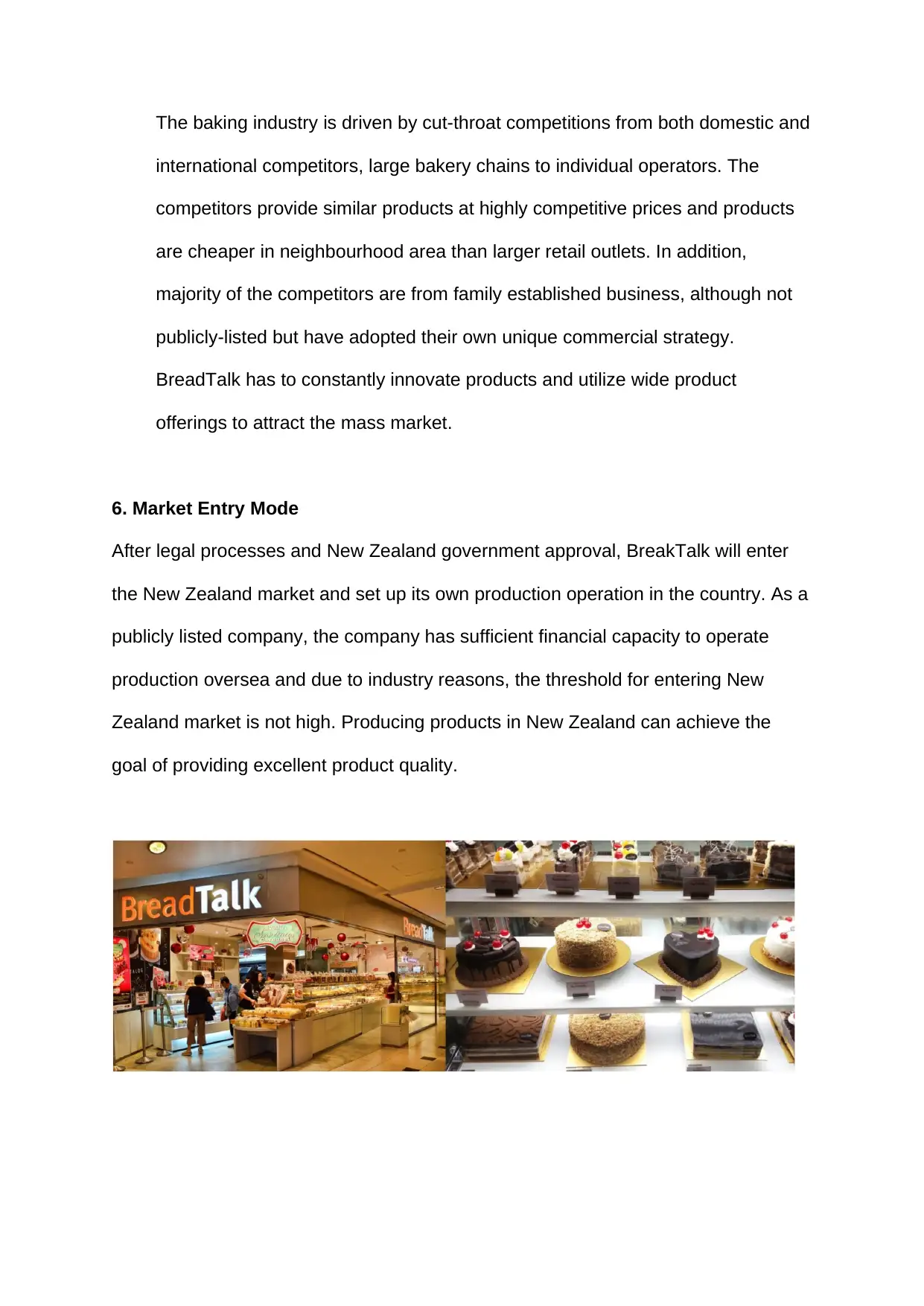
The baking industry is driven by cut-throat competitions from both domestic and
international competitors, large bakery chains to individual operators. The
competitors provide similar products at highly competitive prices and products
are cheaper in neighbourhood area than larger retail outlets. In addition,
majority of the competitors are from family established business, although not
publicly-listed but have adopted their own unique commercial strategy.
BreadTalk has to constantly innovate products and utilize wide product
offerings to attract the mass market.
6. Market Entry Mode
After legal processes and New Zealand government approval, BreakTalk will enter
the New Zealand market and set up its own production operation in the country. As a
publicly listed company, the company has sufficient financial capacity to operate
production oversea and due to industry reasons, the threshold for entering New
Zealand market is not high. Producing products in New Zealand can achieve the
goal of providing excellent product quality.
international competitors, large bakery chains to individual operators. The
competitors provide similar products at highly competitive prices and products
are cheaper in neighbourhood area than larger retail outlets. In addition,
majority of the competitors are from family established business, although not
publicly-listed but have adopted their own unique commercial strategy.
BreadTalk has to constantly innovate products and utilize wide product
offerings to attract the mass market.
6. Market Entry Mode
After legal processes and New Zealand government approval, BreakTalk will enter
the New Zealand market and set up its own production operation in the country. As a
publicly listed company, the company has sufficient financial capacity to operate
production oversea and due to industry reasons, the threshold for entering New
Zealand market is not high. Producing products in New Zealand can achieve the
goal of providing excellent product quality.
⊘ This is a preview!⊘
Do you want full access?
Subscribe today to unlock all pages.

Trusted by 1+ million students worldwide
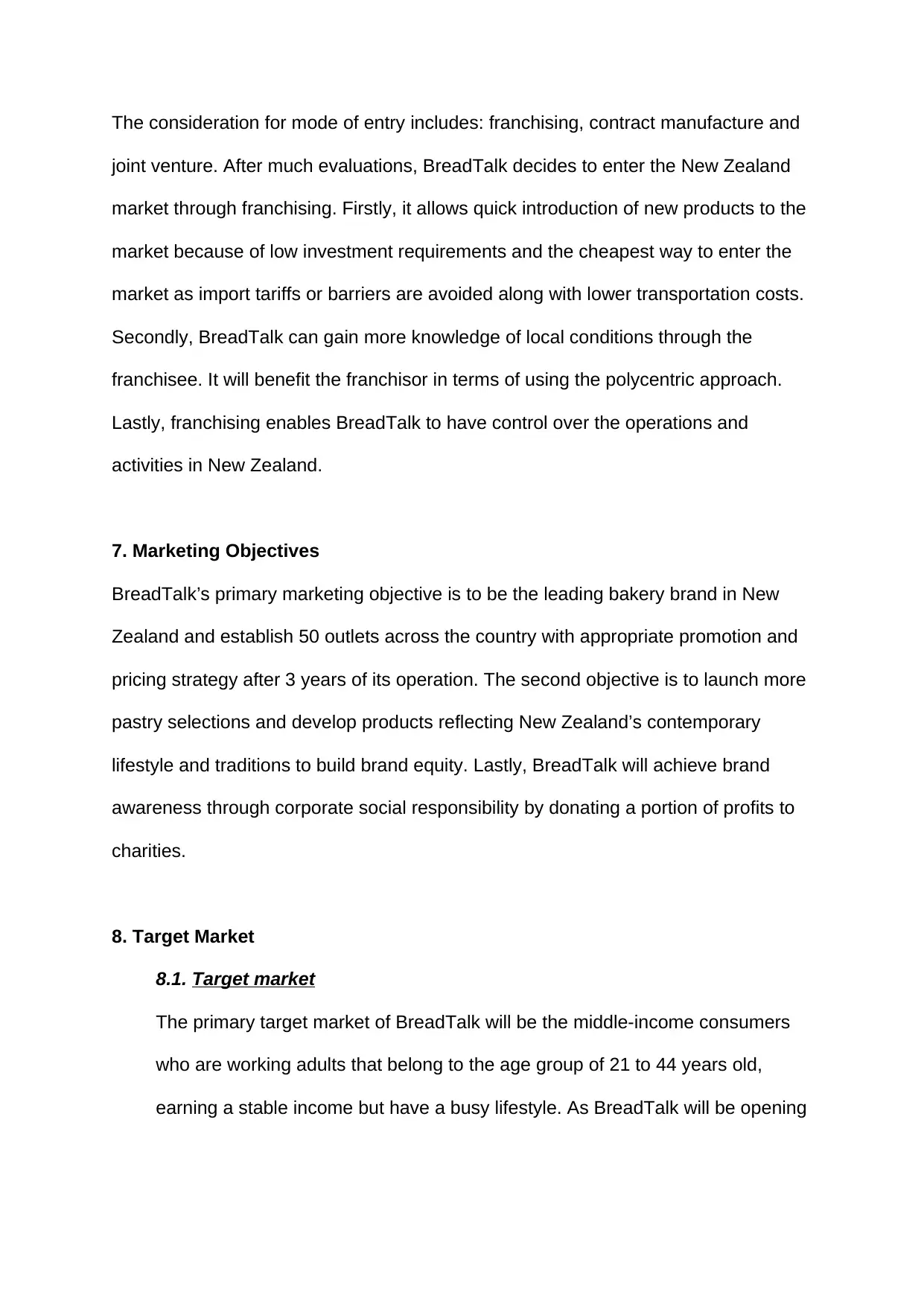
The consideration for mode of entry includes: franchising, contract manufacture and
joint venture. After much evaluations, BreadTalk decides to enter the New Zealand
market through franchising. Firstly, it allows quick introduction of new products to the
market because of low investment requirements and the cheapest way to enter the
market as import tariffs or barriers are avoided along with lower transportation costs.
Secondly, BreadTalk can gain more knowledge of local conditions through the
franchisee. It will benefit the franchisor in terms of using the polycentric approach.
Lastly, franchising enables BreadTalk to have control over the operations and
activities in New Zealand.
7. Marketing Objectives
BreadTalk’s primary marketing objective is to be the leading bakery brand in New
Zealand and establish 50 outlets across the country with appropriate promotion and
pricing strategy after 3 years of its operation. The second objective is to launch more
pastry selections and develop products reflecting New Zealand’s contemporary
lifestyle and traditions to build brand equity. Lastly, BreadTalk will achieve brand
awareness through corporate social responsibility by donating a portion of profits to
charities.
8. Target Market
8.1. Target market
The primary target market of BreadTalk will be the middle-income consumers
who are working adults that belong to the age group of 21 to 44 years old,
earning a stable income but have a busy lifestyle. As BreadTalk will be opening
joint venture. After much evaluations, BreadTalk decides to enter the New Zealand
market through franchising. Firstly, it allows quick introduction of new products to the
market because of low investment requirements and the cheapest way to enter the
market as import tariffs or barriers are avoided along with lower transportation costs.
Secondly, BreadTalk can gain more knowledge of local conditions through the
franchisee. It will benefit the franchisor in terms of using the polycentric approach.
Lastly, franchising enables BreadTalk to have control over the operations and
activities in New Zealand.
7. Marketing Objectives
BreadTalk’s primary marketing objective is to be the leading bakery brand in New
Zealand and establish 50 outlets across the country with appropriate promotion and
pricing strategy after 3 years of its operation. The second objective is to launch more
pastry selections and develop products reflecting New Zealand’s contemporary
lifestyle and traditions to build brand equity. Lastly, BreadTalk will achieve brand
awareness through corporate social responsibility by donating a portion of profits to
charities.
8. Target Market
8.1. Target market
The primary target market of BreadTalk will be the middle-income consumers
who are working adults that belong to the age group of 21 to 44 years old,
earning a stable income but have a busy lifestyle. As BreadTalk will be opening
Paraphrase This Document
Need a fresh take? Get an instant paraphrase of this document with our AI Paraphraser
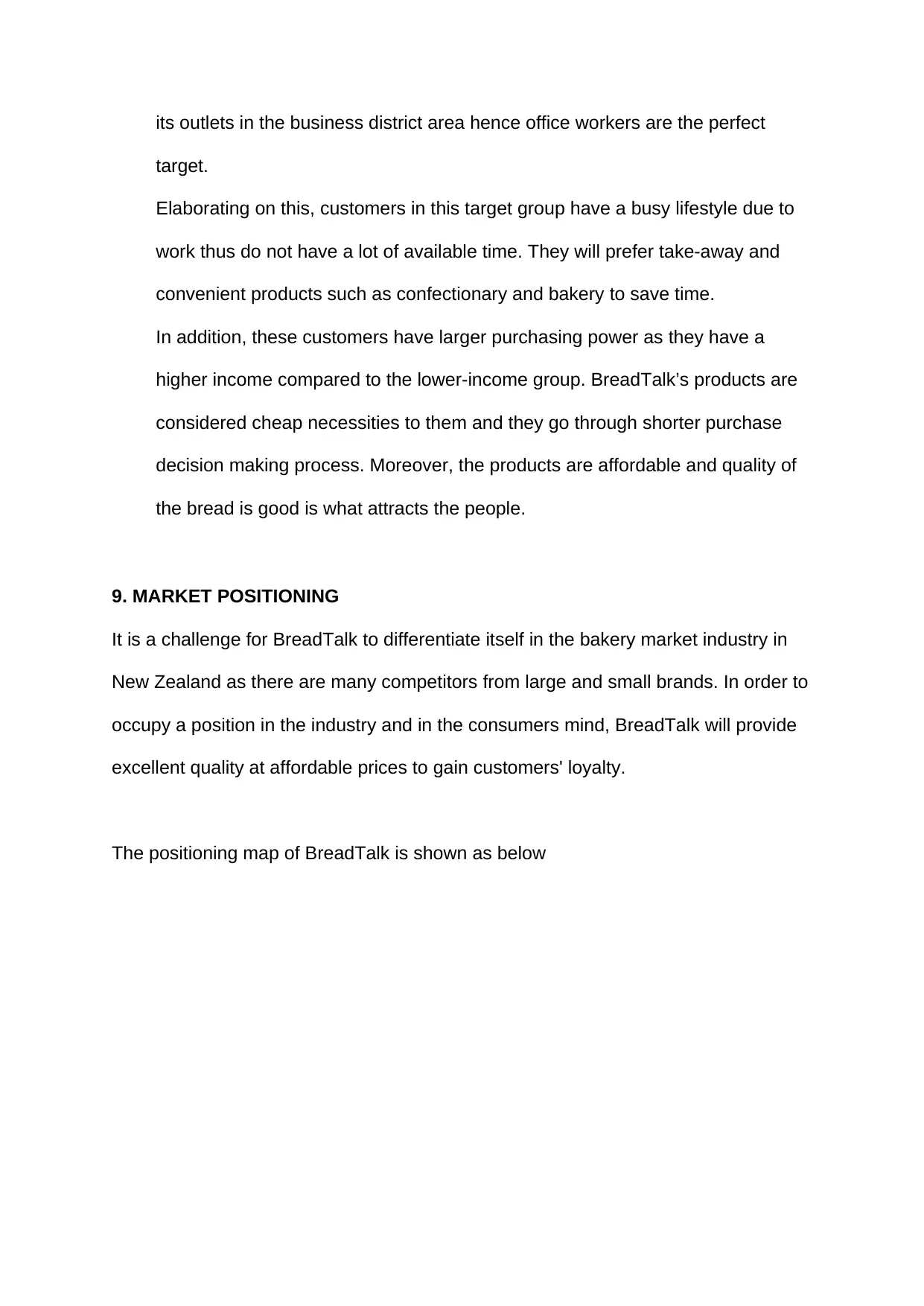
its outlets in the business district area hence office workers are the perfect
target.
Elaborating on this, customers in this target group have a busy lifestyle due to
work thus do not have a lot of available time. They will prefer take-away and
convenient products such as confectionary and bakery to save time.
In addition, these customers have larger purchasing power as they have a
higher income compared to the lower-income group. BreadTalk’s products are
considered cheap necessities to them and they go through shorter purchase
decision making process. Moreover, the products are affordable and quality of
the bread is good is what attracts the people.
9. MARKET POSITIONING
It is a challenge for BreadTalk to differentiate itself in the bakery market industry in
New Zealand as there are many competitors from large and small brands. In order to
occupy a position in the industry and in the consumers mind, BreadTalk will provide
excellent quality at affordable prices to gain customers' loyalty.
The positioning map of BreadTalk is shown as below
target.
Elaborating on this, customers in this target group have a busy lifestyle due to
work thus do not have a lot of available time. They will prefer take-away and
convenient products such as confectionary and bakery to save time.
In addition, these customers have larger purchasing power as they have a
higher income compared to the lower-income group. BreadTalk’s products are
considered cheap necessities to them and they go through shorter purchase
decision making process. Moreover, the products are affordable and quality of
the bread is good is what attracts the people.
9. MARKET POSITIONING
It is a challenge for BreadTalk to differentiate itself in the bakery market industry in
New Zealand as there are many competitors from large and small brands. In order to
occupy a position in the industry and in the consumers mind, BreadTalk will provide
excellent quality at affordable prices to gain customers' loyalty.
The positioning map of BreadTalk is shown as below
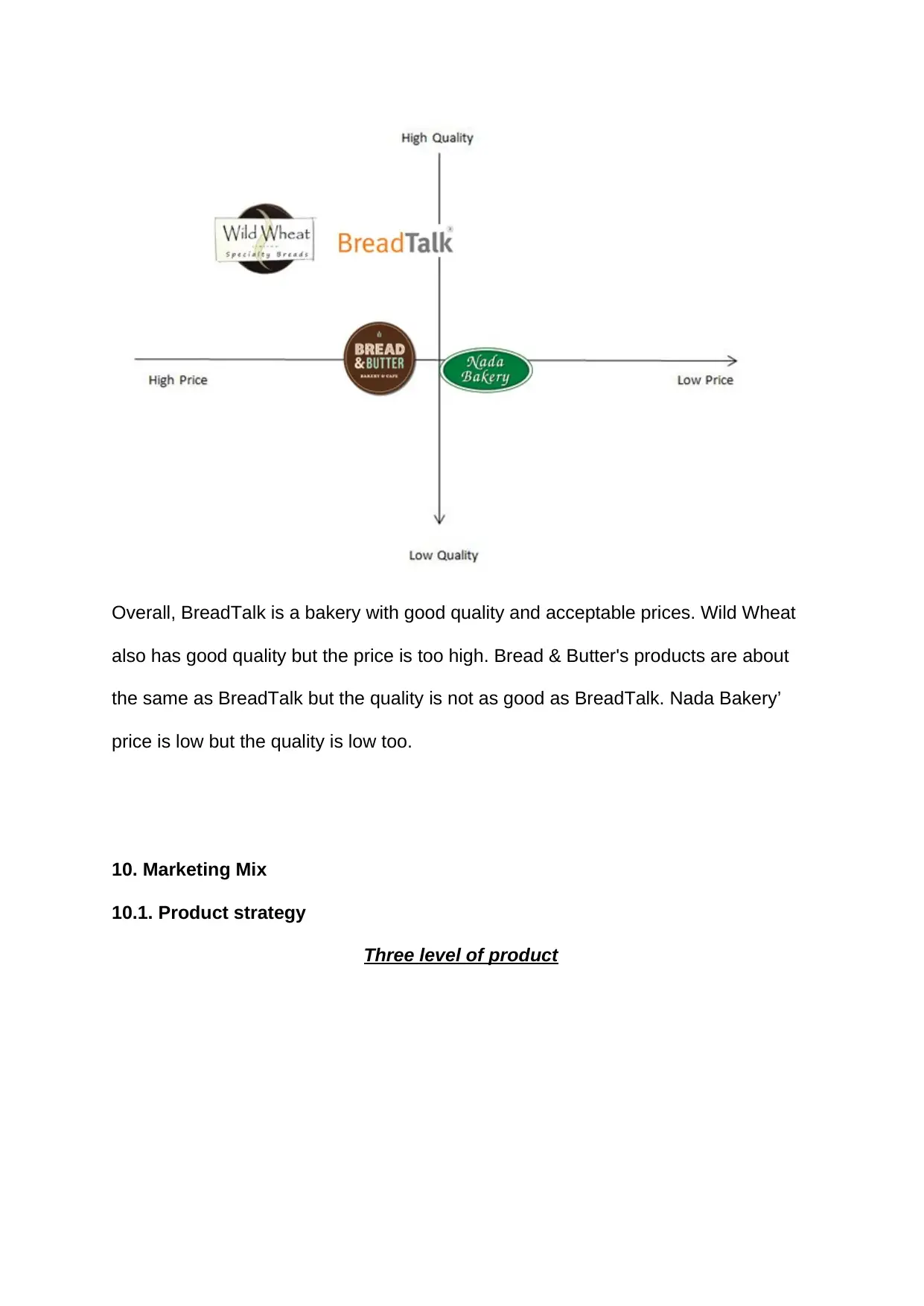
Overall, BreadTalk is a bakery with good quality and acceptable prices. Wild Wheat
also has good quality but the price is too high. Bread & Butter's products are about
the same as BreadTalk but the quality is not as good as BreadTalk. Nada Bakery’
price is low but the quality is low too.
10. Marketing Mix
10.1. Product strategy
Three level of product
also has good quality but the price is too high. Bread & Butter's products are about
the same as BreadTalk but the quality is not as good as BreadTalk. Nada Bakery’
price is low but the quality is low too.
10. Marketing Mix
10.1. Product strategy
Three level of product
⊘ This is a preview!⊘
Do you want full access?
Subscribe today to unlock all pages.

Trusted by 1+ million students worldwide
1 out of 19
Related Documents
Your All-in-One AI-Powered Toolkit for Academic Success.
+13062052269
info@desklib.com
Available 24*7 on WhatsApp / Email
![[object Object]](/_next/static/media/star-bottom.7253800d.svg)
Unlock your academic potential
Copyright © 2020–2025 A2Z Services. All Rights Reserved. Developed and managed by ZUCOL.





